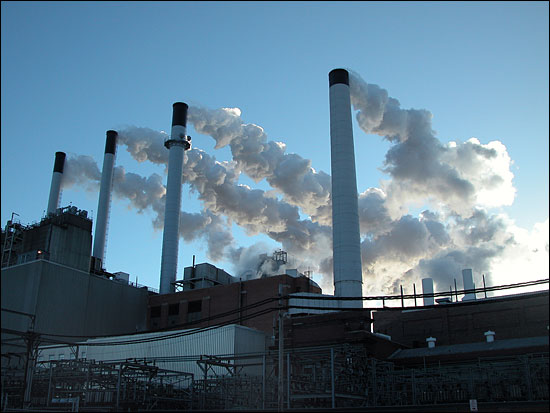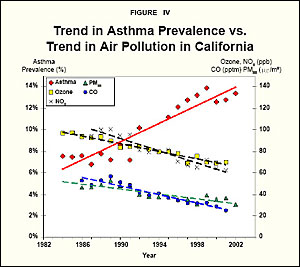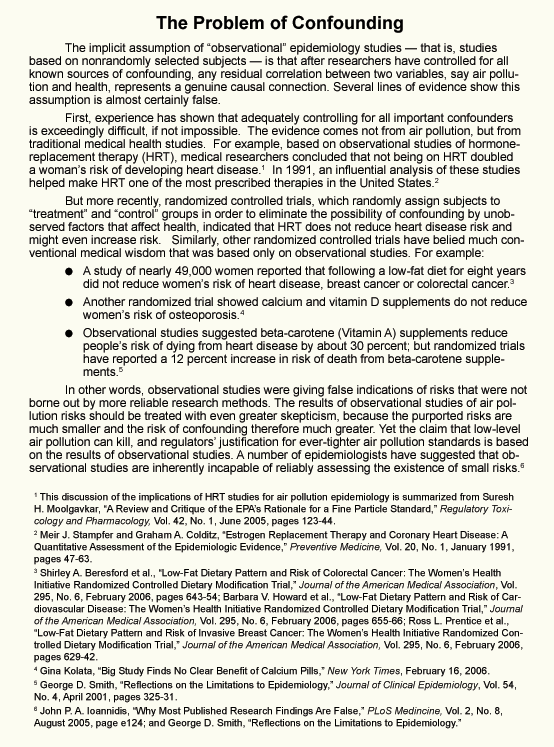Media outlets frequently report that serious health risks such as asthma are increasingly resulting from air pollution and global warming, but the reality is that air quality has been greatly improving for decades, and fears are being instilled in people for the purpose of empowering decpetive bureaucratic agendas.
This article contains an example of a public service announcement which exploits fears of asthma being created by air pollution and global warming, and then it presents excerpts from a National Center for Policy Analysis document entitled Facts Not Fear on Air Pollution which explains realities of air pollution in the United States. The document also explains how air pollution issues are being distorted by politicians and media outlets for spreading fear of health risks for the purpose of political gain.
This information has been reprinted here as a part of the summary article A Reexamination of Climate Change Issues. Text of this page has been hilighted by News of Interest.TV.
A Reexamination of Climate Change Issues
Studies Show Asthma is not Caused by Global Warming
December 11, 2006

Because of efficient “scrubbers” in smokestacks, nearly 100% of the emissions from most coal burning power plants is only CO2, without toxic pollutants. Image from BigStockPhoto.
Jump to sections of this page ..
”Why Does it Take a Polar Bear to Get your Attention?”
Following is a transcript from this 30 second public service announcement:
”The same polluting activities that create global warming are linked to diseases like asthma. 9 million children have been diagnosed with asthma, and kids in low income communities are hit the hardest. We need to stop global warming, and protect everyone’s right to breathe clean air. Why does it take a polar bear to get your attention? Find out what you can do. Visit Powervote.org.”
Note that this announcement is not accurate for a number of reasons. Scientific studies have shown that air pollution is not the cause of asthma, and also the quality of air in the United States has been improving dramatically over the past few decades due to regulations which control the amount of toxic pollutants and particulates that factories and power generating stations put into the atmosphere.
”The same polluting activities that create global warming are linked to diseases like asthma. 9 million children have been diagnosed with asthma, and kids in low income communities are hit the hardest. We need to stop global warming, and protect everyone’s right to breathe clean air. Why does it take a polar bear to get your attention? Find out what you can do. Visit Powervote.org.”
Note that this announcement is not accurate for a number of reasons. Scientific studies have shown that air pollution is not the cause of asthma, and also the quality of air in the United States has been improving dramatically over the past few decades due to regulations which control the amount of toxic pollutants and particulates that factories and power generating stations put into the atmosphere.
Air Pollution and Asthma
Asthma is the most conspicuous example of the extent to which the conventional wisdom on air pollution is demonstrably false. According to the Centers for Disease Control, the incidence of asthma in the United States rose 75 percent from 1980 to 1996, and nearly doubled for children. This rise in the asthma rate may have leveled off since then. (34) Researchers have proffered a number of hypotheses to account for the rise - from increased exposure to roach allergens in urban areas to a decrease in exposure to infectious agents as a result of antibacterial cleansers and antibiotics. (35) But air pollution cannot be the cause, since it declined at the same time asthma prevalence increased. Figure IV displays trends in asthma and various air pollutants for California. The graph displays data for ozone, carbon monoxide, nitrogen dioxide and PM10. While the incidence of asthma has more than doubled in California since 1982, air pollutants of all kinds have steadily declined.
“Asthma levels rose while air pollution levels declined.”

Figure IV. Trend in Asthma Prevalence vs. Trend in Air Pollution in California. view detail
The pattern of hospital visits for asthma suggests air pollution cannot be significantly exacerbating the condition. For example, emergency room visits and hospitalizations for asthma are lowest during July and August, when ozone levels are highest. (36)
Similarly, a study of California children found that while higher ozone was associated with a greater risk of developing asthma for children who played three or more team sports (8 percent of children in the study), higher ozone was also associated with a 30 percent lower risk of asthma among all children in the study. Other air pollutants, such as nitrogen dioxide and particulate matter, were also associated with a lower risk of developing asthma.
“Hospital admissions for asthma are lowest in summer, when ozone levels are highest.”
International data also show that air pollution is not causing asthma. Asthma rates are highest in wealthy Western countries that have relatively low air pollution levels, while developing countries with awful air pollution have low asthma rates. (37) Before 1991, for example, the former East Germany had high air pollution levels and low asthma prevalence. But after reunification East Germans adopted Western lifestyles, incomes increased and air pollution declined - but the incidence of asthma rose to levels comparable to West Germany. (38)
Pollution and Long-Term Effects on Respiratory Health
Popular portrayal and reality also diverge when it comes to the long-term effects of air pollution on respiratory health. In addition to asthma, the Children’s Health Study assessed the relationship between air pollution and growth in children’s lung function. (39) After following more than 1,700 children from age 10 to 18 over the years 1993 to 2001, the study reported no association between ozone and lung growth or capacity. (40) The Children’s Health Study included communities with higher ozone than have ever occurred anywhere else in the country, and even the CHS communities no longer have ozone anywhere near that high. This suggests that even the worst ozone levels in the country are not affecting children’s lung development. (41)
Unlike ozone, PM2.5 actually was associated with a small effect on lung development. Living in an area with PM2.5 concentrations two times greater than the federal standard of 15 µg/m3 was associated with about a 1 percent to 2 percent decrease in lung capacity. (42) Thus, even particulate levels far higher than the federal standard were associated with minimal health effects. And even the areas where the study was performed no longer have PM2.5 levels anywhere near this high.
Despite the minimal effects of air pollution, the press release from the University of Southern California researchers who conducted the study created a misleading appearance of serious harm. Titled “Smog May Cause Lifelong Lung Deficits,” the press release asserted: “By age 18, the lungs of many children who grow up in smoggy areas are underdeveloped and will likely never recover.” (43)
Pollution and Other Health Conditions
Although they don’t publicize it, even regulators and environmental activists have quietly concluded that air pollution is a minor factor in Americans’ health.
- EPA estimated that reducing nationwide ozone from 2002 levels (by far the highest ozone levels of the last six years) to the federal 8-hour standard would reduce respiratory hospital admissions by 0.07 percent and asthma emergency room visits by only 0.04 percent. (44)
- Similarly, California Air Resources Board (CARB) estimates (45) indicate that eliminating all human-caused ozone in the state would reduce respiratory-related hospital admissions by 0.23 percent and asthma emergency room visits by 0.35 percent. (46)
- A study commissioned by the Clean Air Task Force, an activist group, estimated that completely eliminating all U.S. power plant pollution would reduce serious respiratory and cardiovascular health events (e.g., hospital visits) by only 0.4 percent to 1.6 percent. (47)
Power plants contribute roughly a third of all PM2.5 in the United States, yet even environmentalists have concluded, implicitly at least, that they are a minor contributor to respiratory and cardiovascular distress. (48)
How can CARB, EPA and environmentalists estimate that air pollution has a minor quantitative role in public health but then create an impression of widespread harm in their rhetoric? They simply don’t publicize the quantitative estimates and sometimes do not even calculate them explicitly. However, their own estimates show that air pollution is responsible for at most 1 percent or 2 percent of all instances of respiratory and cardiovascular distress. (49)
“Regulators obscure evidence that air pollution has minor health effects.”
Is Air Pollution Deadly? The most serious claim leveled against air pollution is that even current, historically low air pollution prematurely kills tens of thousands of Americans each year, mainly due to soot (PM2.5), but also ozone. (50) The air in developed countries today is by far the cleanest air humans have breathed since the industrial revolution began. And urban air in developed countries today is likely the cleanest urban air humans have breathed since cities were first formed. (51) Can these low levels of air pollution really be killing tens of thousands of Americans each year? Controlled human and animal studies suggest the answer is no.
Even air pollution levels many times greater than Americans ever breathe do not kill laboratory animals. As a recent review concluded, “It remains the case that no form of ambient PM has been shown, experimentally or clinically, to cause disease or death at concentrations remotely close to U.S. ambient levels.” (52)
For example, a Health Effects Institute (HEI) study exposed healthy and asthmatic human volunteers to concentrated ambient PM2.5 collected in the Los Angeles area and had them exercise to increase their respiration rates and therefore their pollution exposures. (53) This represents a “worst-case,” real-world PM2.5 exposure. Even in areas with the highest PM2.5 levels in the country, peak hourly levels rarely exceed even half the level used in this study. (54)
Despite the relatively high PM2.5 levels, there were no changes in symptoms or lung function in either the healthy or asthmatic subjects, and there was little evidence of inflammatory responses.
“Regulators ignore their own studies that find few health effects from pollution.”
Another HEI study exposed both healthy and asthmatic volunteers to high levels of diesel soot for two hours while they intermittently exercised. (55) Once again, despite the high exposure, the researchers found little evidence of an inflammatory response, and the healthy subjects exhibited more evidence of inflammation than the asthmatics.
This laboratory evidence suggests that low-level air pollution does not cause premature death. The claim that air pollution prematurely kills tens of thousands of Americans each year instead rests on indirect evidence from so-called “observational” studies in which researchers look for correlations between air pollution and risk of death.
What They’re Not Telling You
The small effects of air pollution estimated by government agencies are still exaggerations of the real harm from air pollution because they ignore contrary evidence. For example, researchers from Kaiser Permanente studied the relationship between air pollution and emergency room visits and hospitalizations in California’s Central Valley, and reported that higher ozone was associated with a statistically significant decrease in serious health effects, such as hospital admissions. (56) CARB omitted this study from its estimate of the ostensible benefits of a tougher ozone standard. (57) Yet CARB must have been aware of the Kaiser study, because CARB funded it. EPA also did not mention the Kaiser study in its review of ozone health effects. (58)
Omission of contrary evidence on air pollution and health is common in environmental policy activism. At a March 2006 CARB board meeting, staff members gave a detailed presentation on an epidemiological study of the Los Angeles region that reported a stronger link between PM2.5 and mortality than suggested in previous research. (59) What the CARB staff did not tell its board is that another California study concluded that PM2.5 was having no effect on mortality. (60) Several California papers, including the Los Angeles Times, covered the study with alarming findings, but none covered the study that found no effects.
Three journal articles have used data from CARB’s Children’s Health Study to assess whether ozone is associated with increases in school absences. One study reported an increase. (61) Two reported no effect. (62) CARB cited only the first study in its recommendation to tighten California’s ozone standard. (63)
Likewise, the American Lung Association’s Medical Journal Watch Web site mentions only the first. Medical Journal Watch summarizes hundreds of air pollution health studies. (64) But the site omits studies and portions of studies that do not report any harm from air pollution. (65) For example, it does not mention the two studies described above, which found little or no adverse health effects in human volunteers who breathed high levels of PM2.5 and diesel soot, respectively.
Omitting contrary results makes claims of harm from air pollution appear more consistent and robust than suggested by the actual weight of the scientific evidence.
Behind the Myth: Bad Science - The Problem with Observational Epidemiology Studies
Many studies on the health effects of air pollution a type known as “observational” studies. In observational studies, researchers might follow a large group of people from several different areas and see if there is any correlation between air pollution levels and health. Or they might look within an area for correlations between fluctuations in pollution levels and the numbers of deaths or hospital admissions over time.
“Health problems are linked to factors other than air pollution.”
Confounding
Since observational studies are based on nonrandom data, they risk turning up chance correlations between air pollution and health that aren’t due to air pollution at all. For example, if people who live in high-pollution cities are more likely to be overweight or smoke, the studies might attribute health effects to air pollution that were actually caused by poor health habits. This problem, called “confounding,” occurs when some third factor is correlated with both health status and air pollution levels. Researchers take steps to try to control for confounding. However, experience has shown that it is generally impossible to remove all important sources of confounding.
For example, the National Morbidity, Mortality and Air Pollution Study (NMMAPS) reported that in about one-third of the 90 cities studied, higher levels of particulate matter and ozone were associated with lower risks of premature death. (66) How could air pollution kill people in some cities but save them in others? More likely both effects are the spurious result of uncontrolled confounding.
Another recent study showed that previous attempts to link daily air pollution fluctuations with premature deaths suffered from uncontrolled confounding due to weather. Higher temperatures in the summer are associated with higher ozone levels. But heat stress increases people’s risk of death independently of air pollution levels, so inadequately accounting for weather could cause one to conclude that ozone increases mortality when in fact heat stress was the culprit. Two British researchers recently showed that accounting for this and other previously ignored weather effects eliminates the apparent harm from both ozone and particulate matter. (67)
As the sidebar shows, findings from many medical health studies that were based on observational techniques were later shown to be the spurious result of confounding. [See the image below “The Problem of Confounding.”]
Publication Bias and Data Mining
Another challenge to the validity of air pollution health effects studies are problems known as publication bias and data mining. Publication bias refers to the tendency of researchers to seek publication of - and for journals to accept - mainly those studies that find a statistically significant effect, while not publishing studies that do not find an effect. (68)
The related problem of data mining refers to the risk that observational studies can become statistical fishing expeditions that turn up chance correlations, rather than real causal relationships. In other words, scientists tend to choose statistical models to maximize the size of the effect they “expect” or “hope” to find and are more likely to seek publication of studies that find the desired effect. This means the tendency of observational studies to give false indications of risk (or of health benefits) is not random.
If low-level air pollution really has no effect on health, publication bias and data mining would not result in equal numbers of studies reporting harmful and protective effects of air pollution. Rather, because researchers are expecting to find harmful effects, and the funding agencies (usually environmental regulatory agencies or the National Institutes of Health) provide the funding with the intention of demonstrating harm from low-level air pollution, publication bias and data mining favor false indications of harm.
“Scientific journals tend to publish studies that find harm from air pollution and reject studies that find no effect.”
Spurious Risk Estimates
Many researchers consider spurious risk estimates to be a major problem in medical and health research in general. Several new journals - the Journal of Spurious Correlations, the Journal of Negative Results in Biomedicine and the Journal of Negative Observations in Genetic Oncology - have been created specifically to publish negative results and expose spurious risk estimates from previous studies; more such journals are on the drawing board. (69) The problem of spurious risk estimates is especially likely when the subjects are not randomly selected and the putative risks are small - weaknesses that characterize all the observational air pollution studies EPA uses to set health standards. (70)
There are many more examples of observational studies turning up false “evidence” of harm in the form of spurious air pollution-mortality correlations. For example, EPA relied largely on an American Cancer Society (ACS) cohort study to justify its annual PM2.5 standard. However, a reanalysis of the ACS data showed that PM2.5 apparently kills men, but not women; those with no more than a high school degree, but not those with at least some college; and those who said they were moderately active, but not the very active or the sedentary. (71) Results like these are biologically implausible and suggest a failure to adequately control for confounding by nonpollution factors.
Furthermore, when migration rates into and out of various cities over time were added to the ACS statistical model relating PM2.5 and risk of death, the apparent effect of PM2.5 disappeared. (72) Cities that lost population during the 1980s - Midwest “rust belt” cities - also had higher PM2.5 levels. People left these cities, which were in economic decline, in search of work in more economically dynamic parts of the country. But people who work and have the wherewithal to migrate also tend to be healthier than the average person. Hence, what appeared to be an effect of PM2.5 was actually the result of relatively healthier people leaving cities with higher than average pollution levels. Migration was just one of several confounding factors that diminished or erased the apparent harm from PM2.5 but were not accounted for by the ACS researchers.
The original article may be viewed at this link.
A directory of all pages which this document is a part of may be viewed at this link.
References for this article may be viewed at this link.
Article Tree
| A Reexamination of Climate Change Issues |
| Section Directory: An Examination of the Effects of a Warming Climate |
| Studies Show Asthma is not Caused by Global Warming |









